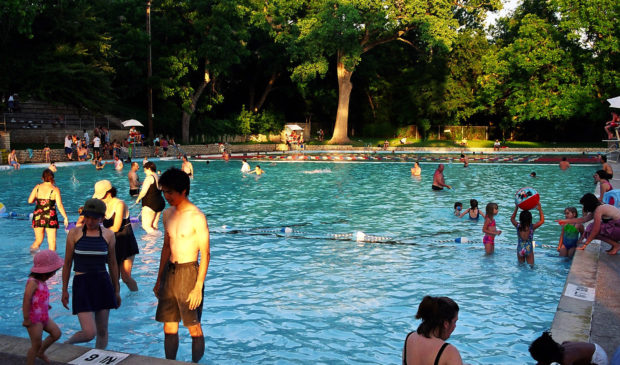Austin pools face major problems
Thursday, July 27, 2017 by
Jack Craver Austin pools are in big trouble.
In a presentation to the Parks and Recreation Board Tuesday night, Acting Department Director Kimberly McNeeley described a system of aging pools that are on life-support due to a lack of investment in maintenance and upgrades.
Commercial pools have a typical lifespan of 25 to 30 years, said McNeeley, while the average age of Austin’s 35 pools is over 50. She likened the state of most of Austin’s aquatic facilities to a car with over 200,000 miles: At the very least they need to be repaired, if not replaced.
The $29 million in capital projects that the pools have benefited from over the past 10 years – mostly from two voter-approved bonds – has not come close to doing the work that needs to be done. Nor does the system’s $6.35 million annual operating budget provide for much more than basic day-to-day upkeep, since 71 percent of the budget is eaten up by staffing costs and most of the maintenance dollars go into utilities or chemicals.
In addition to structural and mechanical issues that put the pools at risk of failure, many of the facilities are not as accessible to the disabled as they should be and lack amenities that make working in the summer heat bearable for lifeguards and other staff, such as shade in the pool area, air-conditioned buildings or refrigerators to store food.
The status quo is also hardly friendly to the environment. The pools leak 350,000 gallons of water a day or 10.5 million gallons a month, the equivalent of what 1,800 households would use. The department also recently discovered that some of its discharge practices are potentially harmful to the sensitive natural areas surrounding some facilities. As a result, they have had to resort to a costlier method in which the discharged water is trucked away to be disposed of elsewhere.
The solution to the myriad issues, said McNeeley, is the Aquatic Master Plan. The document, which was built on feedback from residents throughout a lengthy public engagement process, calls for substantial increases in funding for existing pools as well as the construction of five new pools.
If the master plan is fully funded, the city would spend $8 to $10 million annually over the next 20 years on capital improvements to the aquatic system.
It’s not clear where all of the new money will come from.
The current draft of the multipurpose bond that voters will be asked to approve next year earmarks $15 million for the pools. Besides seeking more money in the bond, the only other options are for City Council to approve diverting more money from the General Fund or for the pools to raise more money through higher entry fees.
Board Member Randy Mann suggested the city should rethink its current policy of free entry to its many small, neighborhood pools.
“I talk to a lot of people who move here from other cities and almost without exception they’re shocked that there are free pools in Austin,” he said.
Mann further argued that the small fees that larger pools do charge for entry should stay within the pool system, rather than going back into the General Fund for Council to spend as it chooses.
Pam O’Connor, a longtime pools advocate who came to address the board, said that she and others had tried for decades to get Council to approve small fees for neighborhood pools but had encountered staunch resistance from elected officials.
It was in recognition of the financial challenges that the master plan includes a rating system for existing pools that can be used to determine which ones to close if the city can’t come up with the money necessary to maintain them all. The plan states that the city should not spend more than $200,000 on repairs for a pool unless the fixes will keep the pool operational for three to five additional years.
The rating system takes into account a variety of factors, some weighted more heavily than others, to assess a pool’s importance and viability.
Board Member Rick Cofer struck a morbid tone in describing the document.
“We’re using a lot of vocabulary to ultimately describe what pools are going to live and what pools are going to die,” he said.
After listening to McNeeley’s presentation, the Parks and Recreation Board declined to recommend that Council adopt the plan. Instead, at the suggestion of Cofer, it voted unanimously to create a working group that will assess the master plan and receive further input from the public on the matter.
McNeeley did not object to the creation of the working group but said that she hoped that she would have the board’s feedback on the plan before she presents the matter to Council on Aug. 1.
Photo by Steve Hopson (SteveHopson on en.wikipedia) (Photograph created by Steve Hopson Stevehopson.com) [CC BY-SA 2.5], via Wikimedia Commons.
The Austin Monitor’s work is made possible by donations from the community. Though our reporting covers donors from time to time, we are careful to keep business and editorial efforts separate while maintaining transparency. A complete list of donors is available here, and our code of ethics is explained here.
You're a community leader
And we’re honored you look to us for serious, in-depth news. You know a strong community needs local and dedicated watchdog reporting. We’re here for you and that won’t change. Now will you take the powerful next step and support our nonprofit news organization?







